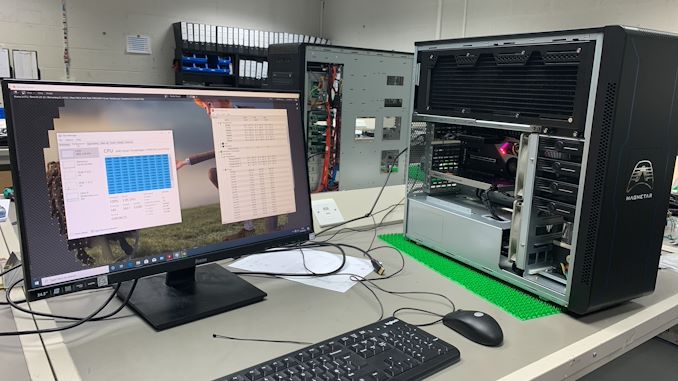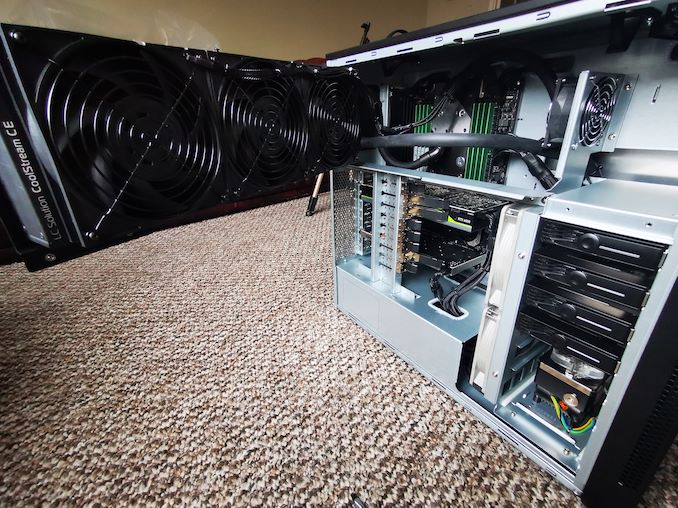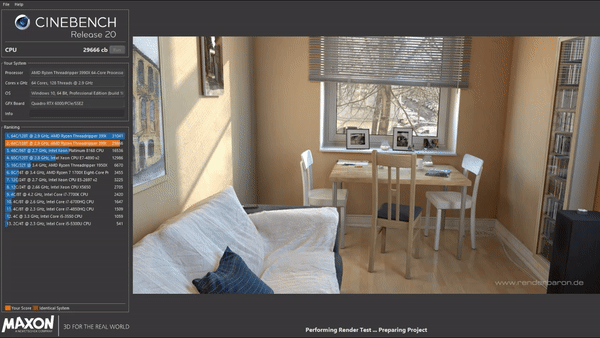The Armari Magnetar X64T Workstation OC Review: 128 Threads at 4.0 GHz, Sustained!
by Dr. Ian Cutress on September 9, 2020 12:00 PM EST- Posted in
- Desktop
- Systems
- AMD
- OC Systems
- ThreadRipper
- 3990X
- Armari
- Magnetar
- X64T
- Rendering
Armari Magnetar X64T
Two of the most significant growth parts of my life have come around extracting as much performance out of a piece of hardware as possible. When I sat doing my PhD, in the lab, pumping out CUDA code to run through simulations in minutes instead of months, the onus was on speed – the more you could simulate in a day, the more insights you could get. As an extreme overclocker, it was pushing the silicon to its absolute limit, even if only for a few minutes, that yielded success and tasted triumph.
Today, as an editor, a technology analyst, and a journalist, the core of ‘getting work done’ is longer contingent on the highest performance computing – it’s about how carefully I can test, how I can manage relationships with vendors and experts, and then what content I can create (at least in a written sense here at AnandTech). The only ‘performance’ aspect to my work is how many systems I can test in a given time, and that is usually more limited by space, hardware, or other projects needing attention. Despite this, that desire for fast computing has never gone away. No matter if I’m dealing with laptop responsiveness, or distributing files over the network, having access to performance makes things easier (or at least if they’re wrong, I can identify a mistake faster!).
For a number of commercial verticals that demand high performance, the nature of that performance can directly affect throughput. Whether it’s something like rapid prototyping, or 3D/visual effects, or animation rendering, or medical imaging and processing, or scientific simulations, it’s all a question of throughput and data. This is the market Armari is targeting with the Magnetar X64T.
In our testing, much with the regular non-overclocked Threadripper 3990X, what the Magnetar X64T does well on it does *really* well. The system has been calibrated to handle integer and floating point workloads around that 4.0 GHz all-core frequency, and our thermal/audio analysis shows it to be easily more than suitable for the workstation market it is going into. The cherry on the top is in getting that SPECworkstation 3 world record, beating the high profile OEMs with a nicely built system.
Not only that, but the price is really impressive. Our system came with a Quadro RTX 6000, 256 GB of DDR4, 3TB of PCIe 4.0 storage, a custom 1600W 80PLUS Gold power supply, a custom chassis, and a three year warranty: for $14200 (pre-tax). Just the Threadripper 3990X and the Quadro RTX 6000 together are a base $8000. Add in the other hardware, the custom liquid cooling setup with a custom block and the TRX40 motherboard and 256 GB of high speed memory, with a 3 year warranty and a free checkup/coolant refill, and I suspect the big OEMs will be hard pressed to match the price. Not only that, the equivalent Intel system, using dual 28-core parts, starts easily costing $20k+ before even looking at memory or graphics.
*Update: The $14200 / £10790 price is a special discount for launch during September 2020.
There are some negative things to highlight, however. For a system that encourages the CPU to draw around twice the power (or more), performance gains for our tests are more in the 30-35% range. The side-effect of overclocking a CPU is that the power efficiency is lower as the processor moves more out of its ideal efficiency range. However one might argue that to match the performance with other hardware requires multiple systems, which has more power draw. Another element will be that this system is limited to 256 GB of non-ECC memory; this is an AMD limitation rather than an Armari limitation, but some of Armari’s customers will no-doubt want similar performance but more memory, and probably ECC memory. And to that end, we also get to a potential performance bottleneck – having 64 cores and 128 threads working at this high speed needs a lot of memory bandwidth. Threadripper can only support 4 channels, and at DDR4-3200 that equates to ~100 GB/s (80-85 GB/s real world), leaving less than 2 GB/s per core. In a number of our tests, we saw this to be a limiting factor.
Something like AMD's Threadripper Pro solves most of these - more memory support, ECC support, eight memory channels. However the overclocking ability would be lost, which for a system like this where the OC performance is what makes it special, removing it would be the equivalent of ripping out its soul. Ideally AMD would need a product that pairs the 8-channel + ECC support with a processor overclock.
All that being said, Armari believes it has built something that its typical customer base will love. It’s a custom super high-performing workstation with a substantial world-record that you can buy, and for the visual effects studios in London that need the horsepower, AMD and Armari has it on tap.
As a small aside, I wondered how well the X64T would do in the ‘extreme’ overclocking leaderboards, where hell fears the liquid nitrogen. The best score I obtained for Cinebench R20 was 31006, which would put it 16th on the all-time leaderboard across all R20 submissions ever – the only way to get a higher score with air or liquid cooling would be to use a dual EPYC server. For Cinebench R15, a score of 12406 gives position #12 in the all-time list. This is somewhat insane for a system someone can just buy.
Here’s a couple our Cinebench R20 runs, in under 15 seconds apiece.
The final question is how to get one (if you were interested). The Armari Magnetar X64T-RD1600G3/FWL is already available for UK and the EU. Armari is in discussions with resellers/distributors in the US, however the warranty arrangement is slightly different. Alongside the X64T, Armari is preparing a rack-mounted 2U version of the X64T with an IPMI-enabled motherboard to come out later in Q4 – something the larger VFX houses have requested en masse. This is set for global certification, and is pending a North American distributor.













96 Comments
View All Comments
WaltC - Wednesday, September 9, 2020 - link
Very impressive box!...;) Great write-up, too! Great job, Ian--your steady diet of metal & silicon is really producing obvious positive results! I would definitely want to go with a different motherboard, though. Even the GB x570 Aorus Master has received ECC ram support with the latest bios featuring the latest couple of AGESA's from AMD--so it seems like a shoe-in for a TR motherboard. I agree it's kind of an odd exclusion from AMD for TR. But, I suppose if you want ECC support and lots more ram support you'll need to step up to EPYC and its associated motherboards. This is a real pro-sumer offering and the price--well, everything about it--seems right on the money, imo. I really like the three-year warranty and the included service to change out coolant fluid every three years--very nice! If I used water cooling that is the only kind of fluid I would want to use--some of these el cheapo concoctions will eat up a radiator in a year or less! Enjoyed the article--thanks again...;)Makaveli - Wednesday, September 9, 2020 - link
"Ideally AMD would need a product that pairs the 8-channel + ECC support with a processor overclock."But why?
I maybe wrong here but when you are spending 10k+ on a build isn't stability more important than overclocking?
MenhirMike - Wednesday, September 9, 2020 - link
Overclocking doesn't have to be unstable - and for some workloads, the extra performance is worth the effort to find the limits and beef up the cooling solution.Ian Cutress - Thursday, September 10, 2020 - link
Had a chat with Armari. The system was built with the OC requirements in mind, and customized to support that. They're using a PBO-based overclock as well, and they've been really impressed with how AMD's latest variation of PBO can optimize the DVFS of the chip to keep the system stable regardless of workload (as long as heat is managed). In my testing, there was zero instability. I was told by Armari that they can build 10, 20, or 50 systems in a row without having any stability issues coming from the processor, and that binning the CPU is almost virtually non-existant.Everett F Sargent - Wednesday, September 9, 2020 - link
So, such a waste of power, time and money.Anyone can build TWO 3990X systems for less then half the price AND less then half the power consumption with each of them easily getting ~90% of the benchmarks.
That is with a top of the line titanium PSU, top of the line MB, top of the line 2TB SSD, top of the line Quadro RTX 4000 (oh damn paying 5X for the 6000 for only less then 2X the performance, what a b1tch, not), top of the line ... everything.
So ~1.8X of the total performance at ~1.8X the cost (sale pricing for all components otherwise make that ~1.9X the cost) and ~0.9X of the total power consumption.
But, you say, an ~15KUS system pays for itself, in less then 1E−44 seconds, even. Magnetarded indeed. /:
TallestGargoyle - Thursday, September 10, 2020 - link
That's a pretty disingenuous stance. Yes, you can split the performance across multiple systems, likely for cheaper, but that ignores general infrastructure requirements, like having multiple locations to set up a system in, having enough power outlets to run them all, being capable of splitting the workload across multiple systems.Not every workload can support distributed processing. Not every office has the space for a dedicated rack of systems churning away. Not every workload can sufficiently run on a half-performing GPU, even if the price is only a fifth of the one used here.
If your only metric is price-to-performance, then yes, this isn't the workstation for you. But this clearly isn't hitting a price-to-performance metric. It's focusing on the performance.
Tomatotech - Thursday, September 10, 2020 - link
Something something chickens and oxen.Or was it something something sports cars and 49-ton trucks? I’ll go yell at clouds instead.
Spunjji - Friday, September 11, 2020 - link
Perish the thought that someone might order one of these with a Quadro 4000 and obviate his biggest gripe (not that it would solve the potential problem of fitting a dataset into 8GB of RAM instead of 24GB)Everett F Sargent - Saturday, September 12, 2020 - link
Well there is that 20% VAT that pushes the actual system price to ~$17K US so dividing by two ~$8.5K per system minus the cost of a RTX 4000 at ~1K US gives one ~$6K US sans graphics card (remember I said build two systems with RTX 4000 at ~$7K US).So I have about ~$2.5K per system for a graphics card. Which easily gives one RTX 5000 per build at ~$2K US. Whiich is 2/3 of the RTX 6000.
But, if the GPU benchmarks are all eventually CPU bound, which appears to be the case here in this review, then yes I get two systems at ~$8K US or ~$16K US for two systems, in other words, I get to build a 3900X system for about ~$1K US to boot..
So no, I would rather see benchmarks at 4K, mind you (as these were at standard HD) with different GPU options. Basically, I would want to use my money wisely (assuming at a minimum a 3990X CPU at ~$4K US as the entry point).
Therefore, this review is totally useless to anyone interested in efficiency (which should normally include everyone) and costs (ditto).
TallestGargoyle - Monday, September 14, 2020 - link
That still doesn't take into account the issues I brought up initially with owning and running two systems.